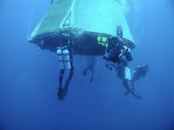@Angelo Farina,
The base goal is open circuit divers not kicking up or destroying the bottom and safely enjoying their dive. The casual diver is unlikely to be motivated enough for your
year-long class nor to spend their dive constantly pushing with hands and feet to fight gravity's rotation. As impressive as it is to fight gravity for the entirety of every dive, or as necessary as it may be with your
rebreather or with heavy tech gear. But this is the basic forum.
So yes, the more assured approach is to have their gear set to make it easy. As they will not be doing the hard approach for long at all. (Whether that counted as 'proper trim control' in your rebreather class or not.)
And as impressive and useful as those active rotational thrusting techniques are. And as useful as they would be on top of a body that gravity was
not trying to put in some unhelpful orientation.
I agree no particular
orientation is perfect for all circumstances. Divers should assume the orientation that best fits the current need.
Neutral trim (coincident mass and volume) makes assuming any
orientation the easiest. So I argue neutral trim is the key for getting casual divers to adapt productive
orientations. As without it, the work is too much for them, so they will just let gravity rule. They are not graduates of your year-long rebreather training and the evidence shows that they do let gravity rule their orientation.
You must be an optimist. I expect people bicycle kicking are doing it because nobody ever taught them to swim properly. Same goes for trim
Michael Phelps will do a great job kicking up the bottom if gravity rotates his hips way below his shoulders. A proper kick would be great, and a frog kick is very useful and smooth. But of no more use to the bottom if it is still directed down at the reef.




